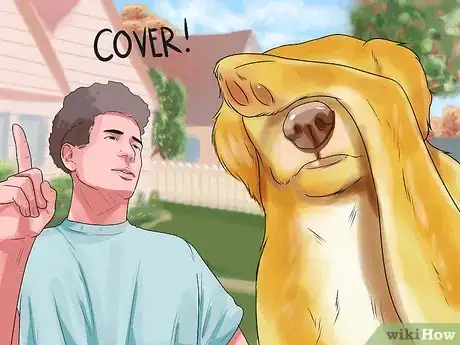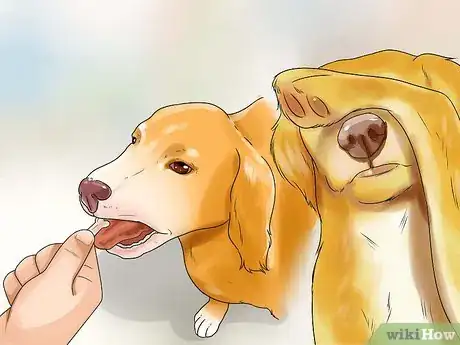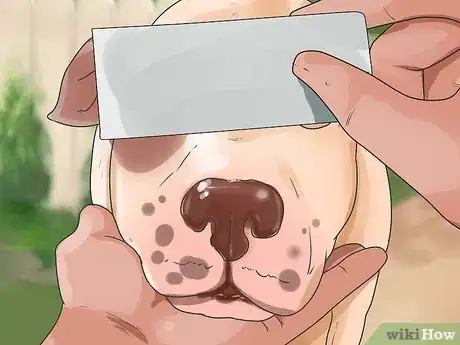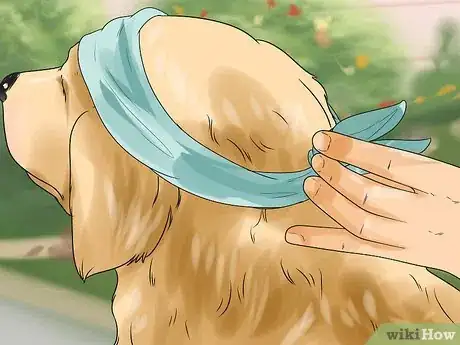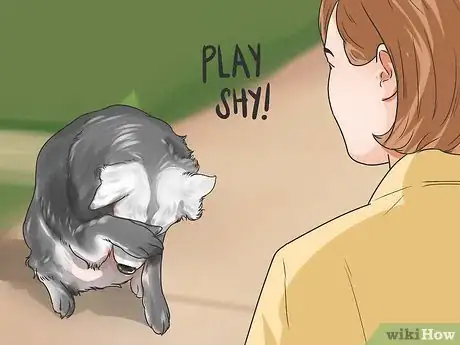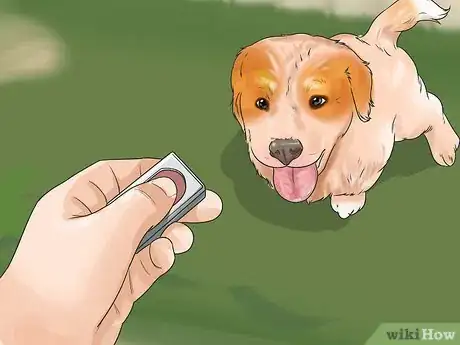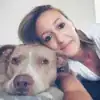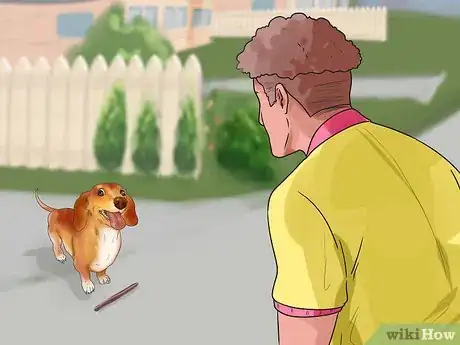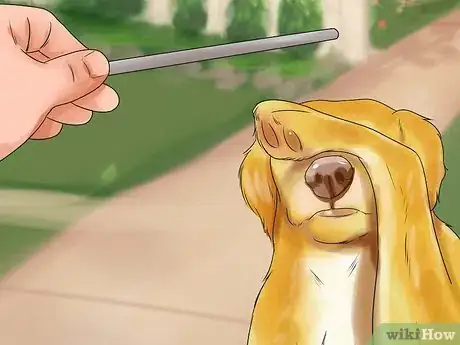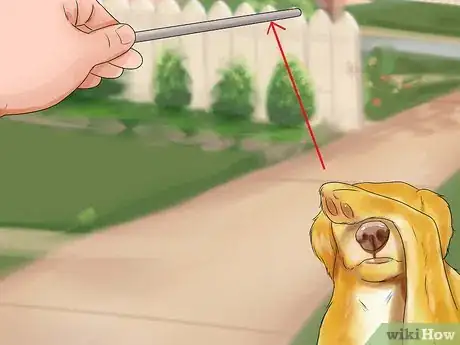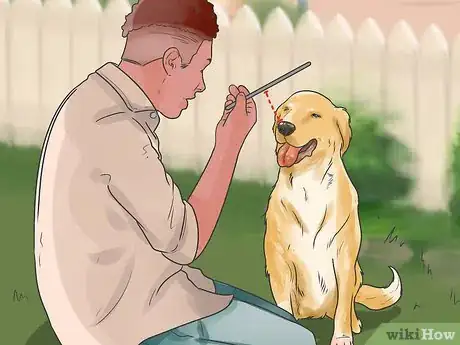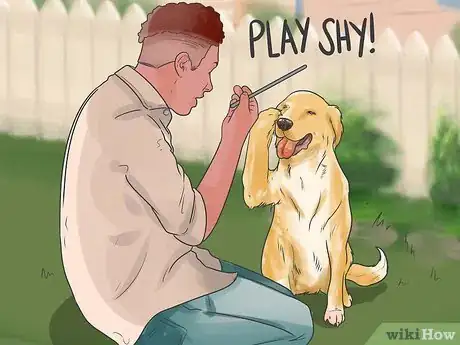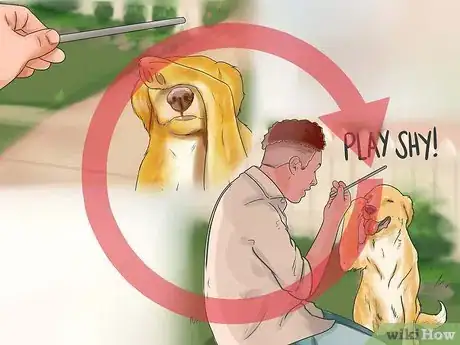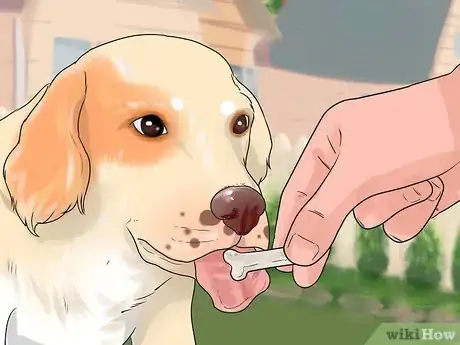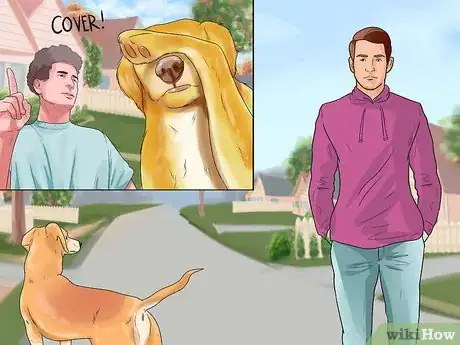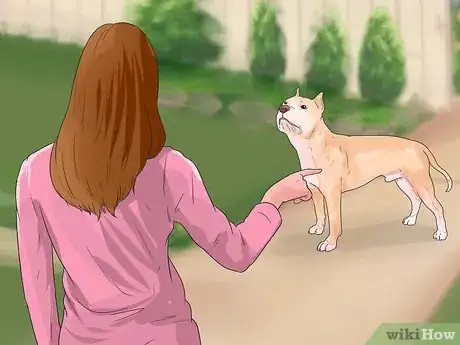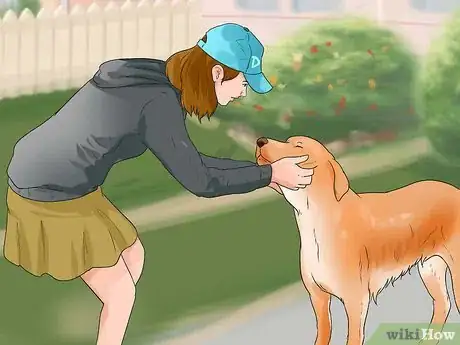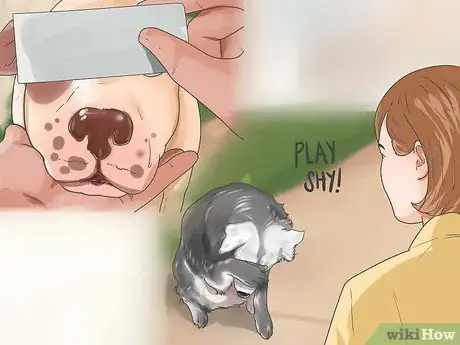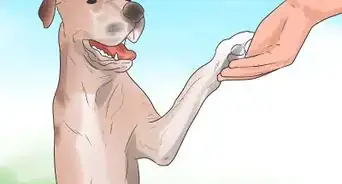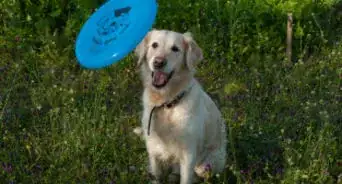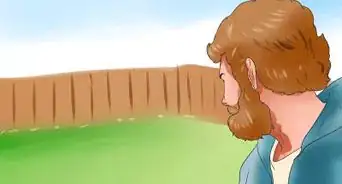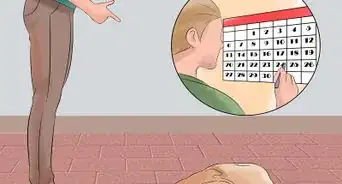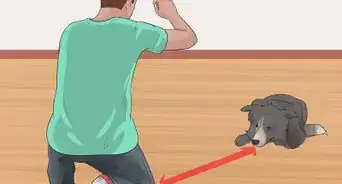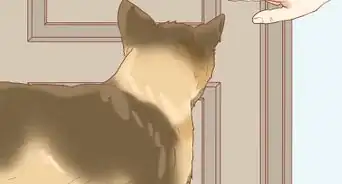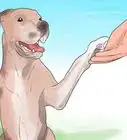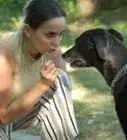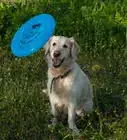This article was co-authored by Jessica Powell. Jessica is a Certified Professional Dog Trainer and the Owner of Proud Paws Dog Training, a small business offering private coaching and in-home dog training services to dog parents across the San Fernando Valley of Los Angeles, California. With nearly ten years of experience, she has extensive knowledge and experience in dog behavior, effective communication techniques, animal welfare, manners training, behavioral modification, and enrichment. Jessica holds a Bachelor of Science degree in Animal Management and is also an experienced shelter professional.
There are 8 references cited in this article, which can be found at the bottom of the page.
This article has been viewed 37,997 times.
Teaching your dog to play shy is easy. With a bit of prodding, your dog’s natural instinct to wipe its eyes or remove an irritating stimulus can be transformed into an adorable and unique trick. With a clicker, some dogs treats, and enthusiasm, your pooch will be playing shy in no time.
Steps
Conditioning Your Dog To Play Shy Using Props
-
1Name the covering behavior when your dog does it naturally. [1] Dogs can understand over a thousand words when trained to interpret them properly.[2] Dogs will often rub their faces or cover their faces with one or both of their paws. When you see this behavior, draw the dog’s attention to it by saying “Play shy!” in a friendly, happy tone.
- Instead of “Play shy!” you can use a similar cue such as “Cover!” or “Hide!” Whatever verbal cue you use to teach your dog to place its paws over its face, be consistent with it. Do not use two commands to teach the same trick.
-
2Encourage the behavior by giving a treat when you see it. After about one week of acknowledging and drawing attention to the dog’s natural covering behavior by calling out “Play shy!” whenever you see the dog’s paws over its face, begin testing your pooch to see if he or she has internalized the command yet. Command your dog to play shy and issue a treat if it obeys. If it doesn’t, help your doggie remember how to play shy. Exclaim “Play shy!” Then place one or both of its paws over its face.
- If you choose to place both paws over the dog’s face, you will first need to get the dog to lie down.
- Whether you choose to place one or both of the dog’s paws over its face, make sure you do it the same way each time. If choosing to utilize only one paw in the trick, always use the same paw. For instance, if you exclaim “Play shy!” and cover your dog’s eyes with its right paw, do not cover its eyes with its left paw the next time you want it to perform the trick.
Advertisement -
3Attach a sticker to the dog’s forehead. Place a post-it note, a piece of tape, sticker, or a band-aid on the center of the dog’s forehead, just above the point right between its eyes. Painter’s tape peels off easily and is also a good choice. Whatever you choose, apply it lightly enough to be noticed by the dog, but not so firmly that removal will be difficult.
- Do not use anything too sticky, or anything that gets tangled in the dog’s fur. If you do, your dog may get hurt and learn that playing shy is a painful, scary experience. This will hurt your chances of getting the dog to learn the trick.
-
4Tie a kerchief over the dog’s eyes. If you do not want to stick something sticky, loop a kerchief over the dog’s eyes and tie it beneath the dog’s jaw. Do not tie the kerchief too tight. Ensure you do not cover the dog’s nostrils. You should be able to fit your pinkie finger between the kerchief and the dog’s body.
- Instead of a kerchief, you could also use a loose elastic headband.
-
5Condition your dog to play shy. With the sticky object stuck to its forehead or the kerchief over its eyes, your dog will be a bit irritated and try to remove the object. Before giving it a chance to do so, hold its paws out in front of it for a few seconds, then cue your dog to action with your phrase of choice (“Play shy!” or some alternative). Release its paws and allow it to remove the foreign object. When the dog learns to associate your command with its action and subsequent reward, you have properly conditioned it.
- Once conditioned, you can take away the kerchief, sticker, or other training object you employed to encourage the dog to place its paws over its eyes. If the dog cannot perform the trick without the object which inspires it to reach across its face with its paw (the lure), you will need to continue practicing until the dog understands the trick. Continue to reward the dog with either a treat or verbal praise.
- If your dog is particularly laid back, it may not remove the lure of its own accord, and you may need to move the dog’s paws to its forehead for it. Take one of its paws in your hand and intone your cue phrase (“Play shy!” or some alternative) before gently bringing its paw up to a point on or just below its eyes. Hold it there for a few seconds, then release, administering a treat or verbal praise.
- Your dog might react in a wiping motion rather than covering its face and holding the position. If this happens, take each of your dog’s paws in your hands gently and fold them.
Playing Shy With Clicker Training
-
1Obtain a clicker and use it to train your dog.[3] A clicker is a small noise-making device which emits a sharp cracking sound when squeezed. These are available at your local pet store or online. When your dog performs a positive action, you should squeeze the clicker, then immediately administer a dog treat and/or fulsome praise.[4]
- It’s alright if teaching your dog to play shy is the first trick it will learn with the clicker. However, if he or she has been trained with the clicker before in more basic tricks such as sit, play dead, or lie down, your dog will learn to play shy through clicker training much faster.
-
2Set a target for your dog’s movement. A target, in dog training, is the place or position you want the dog to be in. Targets will evolve in difficulty for the dog as the training process proceeds. A starting target for training a dog to play shy could be a a ruler or short stick.
- Lay the stick on the floor about 10 centimeters in front of the dog.
- Beckon the dog forward with a treat. When the dog sets his or her paw on the stick, squeeze your clicker and administer the treat. Repeat seven to ten times, alternately administering either a dog treat, or praise (“Good boy/girl!”)
-
3Move the target. Instead of clicking and rewarding your dog when it steps on the stick, life the stick with your hand about halfway up the dog’s body. Hold it close enough that the dog does not need to move forward to touch the target, but can simply reach its paw out to make contact with it.
- If your dog is 30 centimeters tall, hold the ruler or stick in front of him or her at a height of approximately 15 centimeters. When your dog places its paw on the target, squeeze the clicker and administer either a dog treat or generous verbal praise.
- Your dog should recognize that stepping on the target stick is still the goal even though it has changed position. However, you may need to demonstrate to your dog how to step on the stick. Take its paw in your hand and place it on the stick directly one or two times, then click your clicker and administer a treat when after it has held the position for two or three seconds.
-
4Continue elevating the target. Bring the target stick further up the dog’s body. If your dog is 30 centimeters tall and you moved the stick from the ground to a point 15 centimeters up, after seven to ten successful attempts by the dog to place its paw on the stick, move it up to 17 centimeters. Just as before, each time the dog places its paw on the target, squeeze your clicker and administer a treat to the dog. Seven to ten successful attempts later, raise the target up to 19 or 20 centimeters.
- As you elevate the target, shorten it as well. Instead of a ruler or stick, use a straw. After each elevation cut it a bit shorter.
-
5Bring the target closer to the dog’s snout. As you elevate and shorten the target, bring it closer to your dog’s snout, aiming for an area just below its eyes. Once you bring the target object close enough to make contact with the dog’s snout, deploy your cue phrase (“Play shy” or some variation) just before you raise it to the point near your dog's eye. Your dog should, in the final stage, be raising his or her paw to a point where he or she covers or touches this point near the eye. Repeat seven to ten times.
-
6Condition your dog to play shy. When the dog learns to associate your command to play shy with its action and subsequent reward, you have properly conditioned it. Once conditioned, you can take away the target and practice playing shy with only the clicker and dog treats. After a week or so, begin to phase out the clicker as well. Use it every three out of four times instead of every time, then every one of two times after another week or so.
- If the dog cannot perform the trick without the target object or clicker, you may need to go back to an earlier stage of training to reinforce the steps you taught your dog initially. Keep practicing until the dog understands how to play shy.
Following Up With Your Dog
-
1Be consistent in your processes. This means you should try to intone the cue words at the same volume and with the same tone of voice every time you administer the command. Dogs understand both emotional cues and the meanings of the words.[5] When you teach the dog to be shy, you must utilize the word in the same way every time.
- Consistency also means giving the dog a reward at the same time every time it obeys. When training, you should always provide a reward immediately after the dog has accomplished its trick. Let the dog hold the covering position for the same length of time. In the future, the dog will remember how long it is expected to hold the covered position based on the amount of time it did so before.
-
2Reward the dog promptly. When training your dog, you must reward it immediately when it behaves in conformity with your wishes.[6] When it plays shy, exclaim “Good boy/girl!” in an enthusiastic, friendly tone, and give it a doggie treat.[7] Creating the association between playing shy with receiving a reward will encourage the dog to act obediently.
- Treats are a good reward, but need not be the only one. Dogs also respond positively to opportunities to play fetch, or go for a car ride or walk.
- Do not hold treats in your hand while training. The dog will learn that unless the treat bag is present, it need not comply with your commands.
-
3Be the boss while training. Dogs can read body language and posture. Let your dog know you are serious about his or her training by assuming a position of power.[8]
- Stand up straight in front of your dog with your shoulders back when training.
- Keep your hands out of your pockets. Your dog may wrongly (or rightly) believe that you have treats in your pockets, and that will become “the” position he or she identifies with playing shy.
-
4Train your dog everywhere. If you limit training to only one space or room of the house, your dog will think playing shy is something to be done only in that one room.[9] Train your dog to play shy in the bedroom, the living room, the basement, and the backyard.
-
5Be patient and set realistic expectations. Some dogs learn faster than others. Think about how quickly your dog was able to learn to sit, play dead, and roll over. Average those learning times to assess how long it might take for him or her to learn to play shy. Continue to train your dog to play shy and it will learn in time. Do not become frustrated or angry at your dog if he or she is not learning at the pace you desire.[10]
- Take notes at the end of each session and look for small signs of improvement over the long term. Always maintain a positive attitude and celebrate your dog’s progress.
- Relax and take a few deep breaths if you feel you are becoming frustrated or disappointed in your dog’s progress.
- If either you or your dog are growing weary of the training exercise, end it and try again later.
-
6Keep practicing. Train your dog constantly. Training sessions should occur several times each day at random times. Do not train your dog for periods which are too long or too short.[11] Each dog’s attention span varies. Pay attention to your dog’s level of interest; if he or she starts to wander away, lies down, or barks, it may be time to end the practice session and pick it up again later.[12]
Warnings
- Be careful not to poke your dog's eye with your target object.⧼thumbs_response⧽
References
- ↑ https://dogs.thefuntimesguide.com/2008/10/dog_peek_a_boo.php#gsc.tab=0
- ↑ http://www.npr.org/sections/health-shots/2014/11/28/367092004/how-dogs-understand-what-we-say
- ↑ Jessica Powell. Certified Professional Dog Trainer. Expert Interview. 5 October 2021.
- ↑ http://www.dummies.com/how-to/content/how-to-train-your-dog-with-a-clicker.html
- ↑ http://www.npr.org/sections/health-shots/2014/11/28/367092004/how-dogs-understand-what-we-say
- ↑ Jessica Powell. Certified Professional Dog Trainer. Expert Interview. 5 October 2021.
- ↑ http://www.humanesociety.org/animals/dogs/tips/teaching_basic_commands.html
- ↑ http://www.humanesociety.org/animals/dogs/tips/teaching_basic_commands.html
- ↑ http://www.humanesociety.org/animals/dogs/tips/teaching_basic_commands.html
- ↑ http://www.whole-dog-journal.com/issues/14_9/features/Dog-Training-Frustration_20346-1.html
- ↑ Jessica Powell. Certified Professional Dog Trainer. Expert Interview. 5 October 2021.
- ↑ http://moderndogmagazine.com/articles/are-you-making-these-10-training-mistakes/29092
About This Article
To teach your dog to play shy, start by placing a sticker on its forehead or tying a bandana over its eyes. When your dog tries to remove the sticker or bandana with its paw, say "Play shy!" and give it a treat. That way, your dog will associate the movement with the command and getting a reward. Keep practicing like this until your dog paws at its face on command. Then, practice some more without the sticker or bandana, and gradually reduce how many treats you give your dog. For tips from our Veterinary co-author, like how to use a clicker to train your dog, keep reading!
